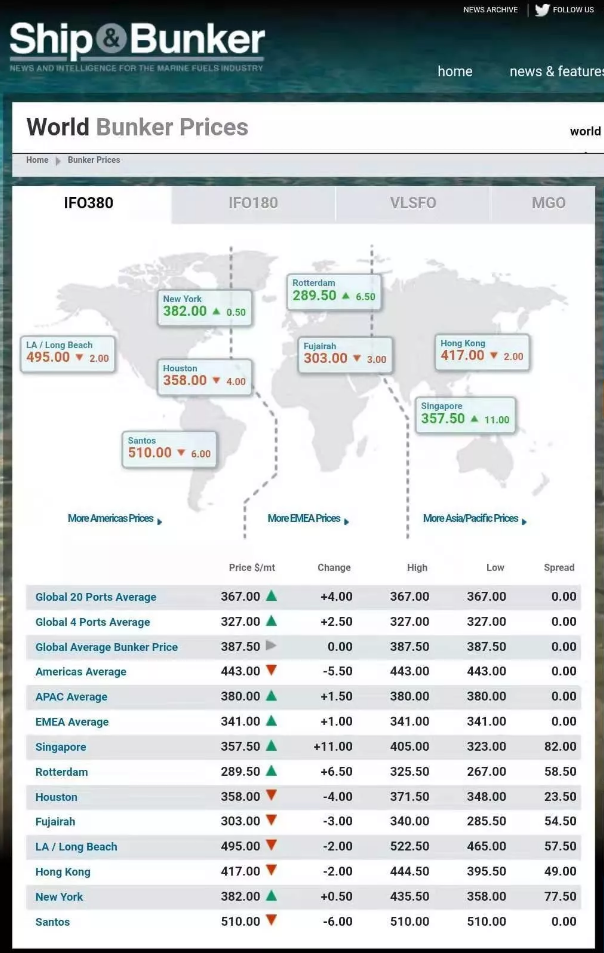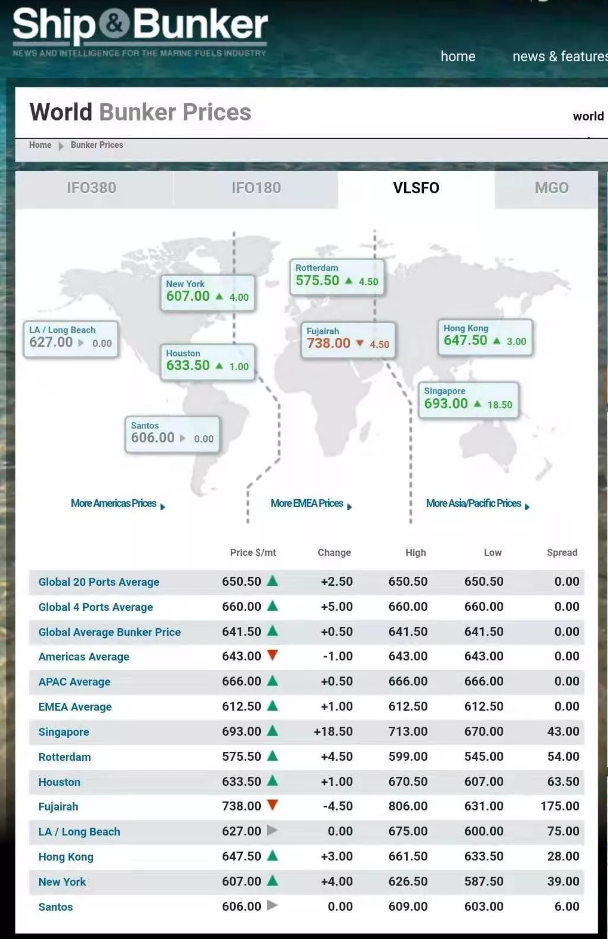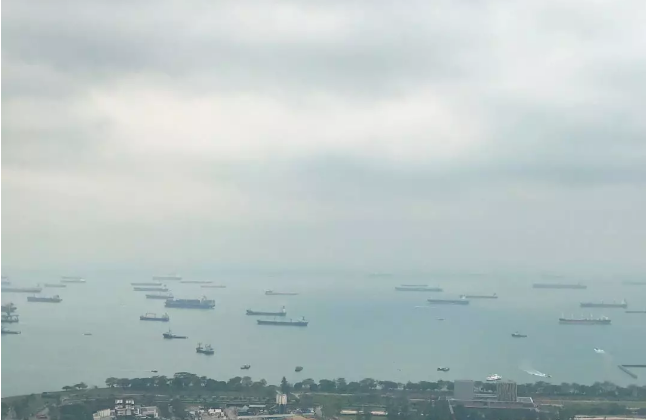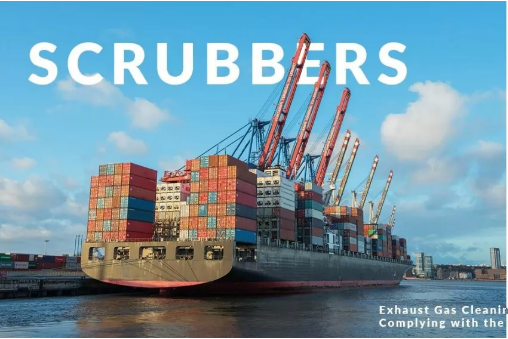The price difference between high and low sulfur oil exceeds 400 $ / ton
- Author:Chelsea
- Source:Seabay
- Release Date:2019-12-26
Fujairah's high and low sulfur oil price breaks $ 400 / t
It has been less than a week since January 1, 2020. According to the latest data from ship & bunker, the world's largest ship fueling center Singapore ’s ultra-low sulfur oil VLSFO price reached $ 693 / ton, while the traditional 380 fuel price was $ 357 / ton. Sulfur spreads exceeded US $ 300 per ton, reaching US $ 336 per ton;
Fujairah's high and low sulfur oil price spread is more than 400 US dollars / ton. Data show that the VLSFO price of this Middle East fuel filling center reaches 738 US dollars per ton, while the high sulfur oil price is only 303 US dollars per ton. In addition, the high and low sulfur oil price spreads of ship fuel filling centers including Rotterdam and Houston are also approaching $ 300 / ton.
It has been less than a week since January 1, 2020. According to the latest data from ship & bunker, the world's largest ship fueling center Singapore ’s ultra-low sulfur oil VLSFO price reached $ 693 / ton, while the traditional 380 fuel price was $ 357 / ton. Sulfur spreads exceeded US $ 300 per ton, reaching US $ 336 per ton;
Fujairah's high and low sulfur oil price spread is more than 400 US dollars / ton. Data show that the VLSFO price of this Middle East fuel filling center reaches 738 US dollars per ton, while the high sulfur oil price is only 303 US dollars per ton. In addition, the high and low sulfur oil price spreads of ship fuel filling centers including Rotterdam and Houston are also approaching $ 300 / ton.


It has been less than a week since January 1, 2020. According to the latest data from ship & bunker, the world's largest ship fueling center Singapore ’s ultra-low sulfur oil VLSFO price reached $ 693 / ton, while the traditional 380 fuel price was $ 357 / ton. Sulfur spreads exceeded US $ 300 per ton, reaching US $ 336 per ton;
Fujairah's high and low sulfur oil price spread is more than 400 US dollars / ton. Data show that the VLSFO price of this Middle East fuel filling center reaches 738 US dollars per ton, while the high sulfur oil price is only 303 US dollars per ton. In addition, the high and low sulfur oil price spreads of ship fuel filling centers including Rotterdam and Houston are also approaching $ 300 / ton.

Fuel tanker temporarily withdraws from the market for tank cleaning
As described by Sindh Maritime in the article "Slow prices of Singapore's low-sulfur oil soared ↑, delays in China and South Korea's fuel refuelling delays", most fuel tankers and barges need to clean their oil tanks for loading before 2020 0.5% of compliant fuel, lack of transportation capacity made fuel supply tight for a time.
Alphatanker also said, "It is clear that some barges began to have clear tanks earlier in the fourth quarter, but as of December, as many as 50% of the world ’s barges were suspended and cleared." "This has caused ships in various weeks to The waiting time for refueling at large refuelling ports has increased significantly, although we believe that a large number of barges will resume service by the end of the month. "
Fuel supply market disrupted
Due to the large-scale delay in the installation of the above-mentioned desulfurization equipment, those ships originally planned to complete the conversion of desulfurization equipment by 2020 will have to use MGO or VLSFO after 2020, which will further lead to tight supply of low-sulfur fuel.
Alphatanker said pessimistically: "There will not be enough VLSFO to meet the needs of shipowners, and they may need to use MGO instead." Although by 2020, the average demand for VLSFO may reach 2.4 million barrels per day, but global production may "Significantly below" 2 million barrels per day.
The consulting firm said: "Many refiners will not begin supplying ultra-low sulfur fuel until the first quarter of 2020 or later."
As described by Sindh Maritime in the article "Slow prices of Singapore's low-sulfur oil soared ↑, delays in China and South Korea's fuel refuelling delays", most fuel tankers and barges need to clean their oil tanks for loading before 2020 0.5% of compliant fuel, lack of transportation capacity made fuel supply tight for a time.
Alphatanker also said, "It is clear that some barges began to have clear tanks earlier in the fourth quarter, but as of December, as many as 50% of the world ’s barges were suspended and cleared." "This has caused ships in various weeks to The waiting time for refueling at large refuelling ports has increased significantly, although we believe that a large number of barges will resume service by the end of the month. "
Fuel supply market disrupted
Due to the large-scale delay in the installation of the above-mentioned desulfurization equipment, those ships originally planned to complete the conversion of desulfurization equipment by 2020 will have to use MGO or VLSFO after 2020, which will further lead to tight supply of low-sulfur fuel.
Alphatanker said pessimistically: "There will not be enough VLSFO to meet the needs of shipowners, and they may need to use MGO instead." Although by 2020, the average demand for VLSFO may reach 2.4 million barrels per day, but global production may "Significantly below" 2 million barrels per day.
The consulting firm said: "Many refiners will not begin supplying ultra-low sulfur fuel until the first quarter of 2020 or later."

Shipping industry faces short-term chaos
Large oil companies and shipowners have spent billions of dollars preparing for IMO2020, but energy analysts have expressed concern that many in the oil and shipping industry are still unprepared.
Xeneta CEO Patrik Berglund pointed out that "the market is constantly changing. No one seems to know what the end result will be." He previously described the IMO 2020 as a "rare life-long opportunity" for shipping liners to raise prices because The cost of the entire industry is expected to increase. "We originally expected these costs would definitely increase, but the shipping and freight companies certainly did not take advantage of this opportunity. It is surprising."
"The market is completely chaotic and customers are troubled by all these uncertainties," Bergland said.
More than 170 countries, including the United States, have signed fuel replacement agreements. This means that ships that violate the new law are in danger of being detained, and ports in participating countries will monitor incoming ships.
ClipperData's Smith stated that prior to the implementation of IMO 2020, it was clear that demand for light, low-sulfur crude oil was "very large," noting that a record amount of US crude oil had entered the European market since November.
"At the same time, you see Russia ’s Ural exports of heavy sulphur crude oil declining due to reduced demand," he said.
The two largest container shipping companies in the world: A.P. Moller-Maersk and MSC both said that if they comply with IMO regulations, they will incur at least 2 billion yuan in additional expenses for individual companies.
Asked what market participants expected when the stricter transportation fuel standards came into effect, Tamas Varga, senior analyst at PVM Oil Associates, said: "I think it's chaos and uncertainty." "A lot of people I don't know what will happen. Everything will not be known until next year. "
Large oil companies and shipowners have spent billions of dollars preparing for IMO2020, but energy analysts have expressed concern that many in the oil and shipping industry are still unprepared.
Xeneta CEO Patrik Berglund pointed out that "the market is constantly changing. No one seems to know what the end result will be." He previously described the IMO 2020 as a "rare life-long opportunity" for shipping liners to raise prices because The cost of the entire industry is expected to increase. "We originally expected these costs would definitely increase, but the shipping and freight companies certainly did not take advantage of this opportunity. It is surprising."
"The market is completely chaotic and customers are troubled by all these uncertainties," Bergland said.
More than 170 countries, including the United States, have signed fuel replacement agreements. This means that ships that violate the new law are in danger of being detained, and ports in participating countries will monitor incoming ships.
ClipperData's Smith stated that prior to the implementation of IMO 2020, it was clear that demand for light, low-sulfur crude oil was "very large," noting that a record amount of US crude oil had entered the European market since November.
"At the same time, you see Russia ’s Ural exports of heavy sulphur crude oil declining due to reduced demand," he said.
The two largest container shipping companies in the world: A.P. Moller-Maersk and MSC both said that if they comply with IMO regulations, they will incur at least 2 billion yuan in additional expenses for individual companies.
Asked what market participants expected when the stricter transportation fuel standards came into effect, Tamas Varga, senior analyst at PVM Oil Associates, said: "I think it's chaos and uncertainty." "A lot of people I don't know what will happen. Everything will not be known until next year. "
